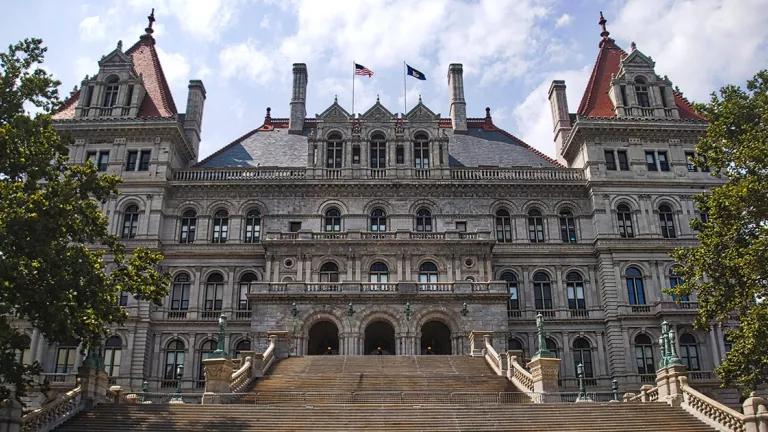Clearing the Air: Ahmedabad’s AIR Plan in Action

This week, thousands of world leaders, environmental advocates and researchers are gathering in San Francisco for the Global Climate Action Summit (GCAS). The event signals global progress toward mitigating climate change and better adapting to a significantly warmer world.
At an official GCAS affiliate event highlighting Climate Actions in India, Ahmedabad Mayor Bijalben Patel will discuss the findings of new efforts to address the city's air pollution challenge. The study, published in the International Journal of Environmental Research and Public Health, describes how the western Gujarat city is addressing the grave environmental and public health threat that air pollution poses to its more than six million residents.
Linked Problems, Shared Solutions
Climate change and air pollution are linked problems. The combustion of dirty fossil fuels is a major contributor to dangerous air pollution in India, and also exacerbates the greenhouse gas emissions that drive climate change. Research shows that climate change itself will likely make air pollution problems worse, through direct and indirect mechanisms. For example, India is expected to experience a surge in use of air conditioning, which helps people cope with extreme heat, but can be energy intensive and contribute to fine particulate matter (PM2.5) and ozone air pollution.
However, just as these major environmental problems are linked, so are the solutions. Shifting India even further toward clean energy and energy efficiency can help to stem deadly air pollution and protect the global climate. California, for instance, has shown incredible progress in advancing its greenhouse gas emissions targets through smart environmental policies while also achieving some of the fastest economic growth in the U.S.
As our study describes, the Air Information and Response (AIR) Plan (launched in 2016 by the Ahmedabad Municipal Corporation, AMC) focuses on five key strategies:
- A health-based Air Quality Index (AQI) warning system and strengthened interagency coordination based around air pollution levels
- Enhanced public awareness and communication outreach, using new air quality data to inform the public
- Focused activities to protect children’s health, including a school flags program based upon the AQI forecast
- Targeted environmental health capacity building for medical professionals, who are on the front lines of treating respiratory disease
- Support for research on future air pollution exposure reduction and source mitigation pathways
Together, these strategies are helping Ahmedabad to better quantify the burden of air pollution in the city, to better inform local citizens about the health risks of air pollution, and to better strategize a policy path forward for achieving cleaner air.
Stronger Environmental Monitoring
The centerpiece of Ahmedabad’s AIR Plan is a set of 10 new, continuous air quality monitors that measure local levels of harmful air pollution. The data from these state-of-the-art monitoring stations informs the city’s real-time AQI, which summarizes air quality data in a single metric and distills information on associated health risks in a way that is accessible to the public. The monitoring system and AQI are spearheaded by the Indian Institute of Tropical Meteorology’s System for Air Quality and Weather Forecasting and Research (IITM-SAFAR) program. In addition to Ahmedabad, IITM-SAFAR also operates comprehensive monitoring and AQI systems in three other Indian cities (Pune, Mumbai, and New Delhi) and brings its expertise gained from this work to the project in Ahmedabad.

Enhanced Public Engagement
The new study notes that strategies to tackle India’s air pollution problem are necessarily multi-pronged and require support and engagement from the public in order to succeed. The AMC is working to widely disseminate information about air quality, with the aim of protecting health by reducing dangerous environmental exposures for all citizens. This goal is especially important for vulnerable populations, like children who are at an elevated risk of air pollution-related health impacts.

Collaborative, Cross-Sector Partnerships
The AIR Plan was developed and implemented by a team of local stakeholders bringing sustained enthusiasm and deep, interdisciplinary expertise to the table. At the center of the coalition is the municipal city government, the AMC, which is responsible for the city’s civic infrastructure and administration. Led by the mayor and municipal commissioner, the AMC Health Department has pioneered community health strategies for decades.
Beyond the AMC and IITM-SAFAR, local public health leaders at the Indian Institute of Public Health-Gandhinagar and the Public Health Foundation of India, educators, medical experts, and a cohort of local researchers with expertise in environmental science and policy are putting the AIR Plan into action. Specifically, a cross-sector expert working group is currently engaged in active discussions to better understand the key sources of air pollution in and around the city and assess international best practices in order to develop policy recommendations for the AMC to address the local air pollution burden.
Lessons Learned
The experience of developing and implementing the AIR Plan in Ahmedabad offers a number of tangible lessons to other cities in India, as well as to other countries that are striving to address the serious problem of urban air pollution. Specifically, the published study notes that Ahmedabad’s AIR Plan has succeeded because of:
- strong partnerships that draw on interdisciplinary expertise to tackle a complex environmental health problem
- a sustained, stakeholder-focused approach that prioritizes community engagement at the outset
- a solid scientific foundation and reliance on transparent, tested technology for documenting and reporting air quality, which builds trust and allows for the establishment of a research base on which to craft informed air quality management policies
- a prioritization of health-centered interventions that achieve near-term benefits while also laying the foundation for sustainable progress towards larger environmental and public health goals, such as mitigating the key sources of air pollution that drive climate change
Beyond Ahmedabad: Climate Resilience in India
As our new study notes, Ahmedabad is among the first Indian cities where local leaders, state government partners, the national environmental ministry and civil society are proactively working together to address the country’s major air pollution challenge with a focus on public health. As India’s forthcoming National Clean Air Programme lays out an ambitious agenda for addressing the country’s urgent air pollution challenge, the lessons learned from the development of Ahmedabad’s AIR Plan can serve as a template for other cities working to address the heavy burden of air pollution and climate change on public health.
This blog was written by the above authors and Sayantan Sarkar, a climate resilience expert working with NRDC as a consultant in New Delhi.




